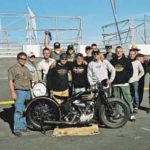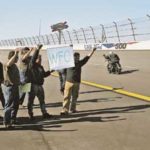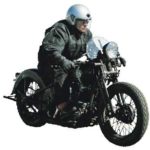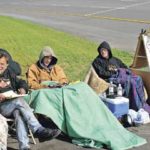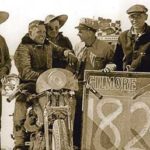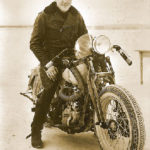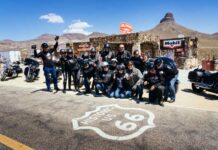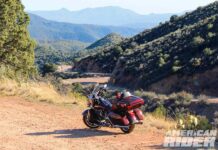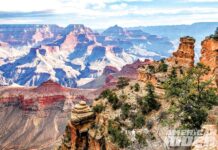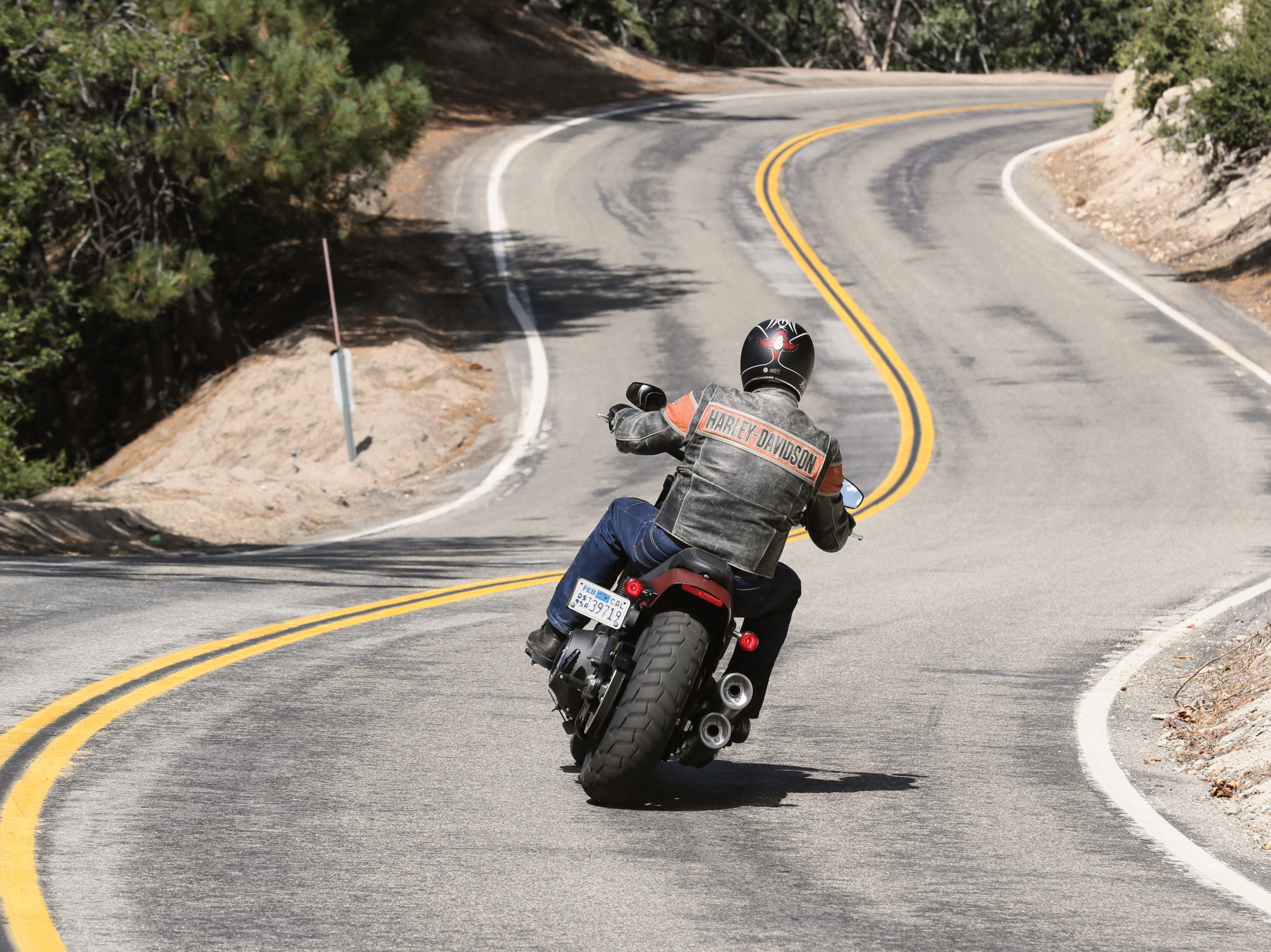Ironhead bikes and stubborn men
Team attempts 2,000 miles at Talladega
Talladega, Ala., April 4–5—At 2:30 p.m. on April 8, 1937, California motorcycle patrolman Fred Ham climbed aboard a new Harley-Davidson EL Knucklehead determined to break a series of endurance riding records that had been established 15 years earlier by Wells Bennett on an Indian motorcycle. Twenty-four hours, 1,825 miles and 43 records later, Ham emerged as the world’s undisputed long-distance champion. Seventy years later, a team assembled and led by Dale Walksler, owner and curator of the Wheels Through Time Museum, gathered at the Talladega Superspeedway to celebrate Ham’s record-setting ride. The team would honor Ham’s record by attempting to ride 2,000 miles on the track at the speedway in 24 hours. Their weapon of choice? A 1937 EL Knuckle, of course.
According to historic records, Fred Ham was a man of enormous physical strength and possessed of a driving energy and vitality. Before his 24-hour record he had been a winner of the Big Bear Enduro and holder of the Three Flags endurance record (Canada to Mexico). He was known along the West Coast as “Iron Man Ham” long before the term became vogue. His 24-hour ride was conducted aboard a stock bike with an engine prepared by Bill Graves and ran over a five-mile circular course at California’s Muroc Dry Lake. His support team consisted of a wide variety of mechanics and helpers, with Fred Ludlow acting as his riding coach and Graves as his crew chief. The Gilmore Oil Company provided hundreds of flares and the fuel required to light the course during the night.
The Knuckle used was an EL 61 c.i., unmodified except for some internal motor polishing, the addition of a small windscreen and an induction tube mounted to the carburetor to keep out the abrasive dirt of the dry lake. Early in the run, a frozen kickstarter bearing necessitated a push start in high gear after each pit stop. Although plagued with additional problems throughout the setting of the record (including split oil lines and melted spark plugs), the most time-consuming problem Ham and his team experienced involved the Knuckle’s primary drive chain. It had never been broken in properly and needed continuous adjustment. But the team and rider refused to quit and in the end, after a valiant group effort, succeeded in shattering every noncompetitive mark from one to 24 hours and from 50 to 1,800 miles.
Modern history
Seventy years later, another lone rider astride a vintage ’37 Harley took to the Talladega track with a vision of setting a new record. The rider was Wayne Stanfield, 59, of Santa Ana, California. He’s no stranger to the grueling challenges of motorcycle endurance competition. With a background similar to that of Ham, Stanfield also had off-road enduro experience and teamed with Dale Walksler in 1995 to take fifth place out of 95 teams in the Great American Race from Ottawa to Mexico City. Stanfield was aboard a Wheels Through Time 1937 Harley. The following year, Walksler again fielded a ’37 that Stanfield rode in the Great American Race from Tacoma, Washington, to Toronto, Canada, finishing second overall and missing the first-place victory by one second. In 1997, Dale and Wayne set a cross-country record using a 1917 Henderson motorcycle. For the last 10 years, the dream of celebrating Ham’s 1937 record has been at the forefront of these seasoned veterans’ minds.
Walksler and his crew at the Wheels Through Time Museum prepared the Knucklehead in a manner identical to the one used by Ham. The motor was built using no high-performance parts and, other than some internal polishing (just as in the original), was in complete stock trim. Remaining true to Ham’s effort, a small windscreen and an induction tube, both similar to the original, were added. One additional piece of technology that was included on the 2007 run that was not available in 1937 was a Garmin GPS navigation system mounted on the tank for speed measurement.
Walksler was quick to point out that, although reaching the 2,000-mile point was a goal, by no means was their effort intended to upstage the accomplishments of Fred Ham. Dale stated, “He was one of the greatest endurance riders and no one will ever surpass his feat at Muroc Dry Lake. Besides, that was then and this is now. He was on a hard dirt surface and we are at a paved superspeedway. And although we have tried to duplicate his motorcycle in mechanical detail, it is a fact that lubricants and tires are far superior today, and all of these factors will give us an advantage.” Walksler was to serve as crew chief during the run but had called in the talents and unique disciplines of two other teams, Acme Motorcycles from Michigan and Hourglass Racing from Georgia. As the effort progressed, every available hand would be needed.
All three teams (and a few independent assistants and invited guests) assembled at a pit stop on the backstretch of Talladega Superspeedway (between turns 3 and 4) on Wednesday, April 4. It was high noon. In an effort to ease some of the trackside tension, around 1:30 a barbecue pit was fired up and someone tossed on a platter of Italian sausages. But even though everyone tried to be light and jovial, there was a palpable edge to today’s activities and a somber tone was heavy in the air, especially near Dale Walksler—the man was consuming cigars one after another, smoking half and chewing the remainder.
At 2:00, Dale took half a dozen warm-up laps around the 2.83-mile course, hitting a high of 94 mph and averaging 85. Things were looking good—until he pulled back into the pit. The bike was shrouded in oil smoke with a fine film covering the oil tank and transmission. First thoughts were that someone had added too much oil. That idea was quickly tossed and it was soon determined that there was a vacuum loss at the rocker cover and the excess oil was not vacating the rear head “cup.” After an hour of near frantic wrenching, the “official” start time of 4:00 p.m. was drawing near. The start time could be delayed, of course, but not forever. After a safety meeting with track officials at 3:30, Dale jumped back on the bike for another test run. The old Knuckle was still blowing oil and leaving a bunch of talented mechanics scratching their collective heads. In desperation, Walksler lowered the oil pump bypass pressure. It seemed to work and the machine was no longer weeping 50-weight.
Wayne Stanfield left the pits at exactly 4:00, but in nine minutes was nursing the ailing bike back home. In three minutes it was determined that a defective vented gas cap was the culprit. The forward-thinking Walksler had brought along a couple of “spare” bikes for just such an emergency— an antique H-D flattie and another Knuckle. Stealing a gas cap from the flathead, Stanfield roared back onto the track only to return after several laps with complaints of continued power loss. Points were checked, plugs were changed and the carburetor was tinkered with. It was finally decided to have a complete restart at 4:40 p.m. But it was also decided that would be the first and only restart—at that time they would go for broke.
After the restart, Iron Man Stanfield made less than five laps before limping back into the pits. Nine minutes later he was back on the course with a new float bowl for the Linkert carb after a faulty needle valve was discovered. Wayne charged the track hard and ran the bike at top speed in an attempt to make up for lost time. Confidence in the pit crew increased as the Knuckle continued to make the laps and began to pile up some decent mileage figures. Was this it? Were we on our way to be witnesses to a new record? It was looking good. At least until 5:30, when the bike stuck a rear exhaust valve. But Dale refused to surrender. Dumping what appeared to be a full pint of synthetic oil into the rear head, he had his crew push him until the valve was free, the cylinder cleared and the bike fired back to life. The ’37 seemed to be just as determined as the technicians attending to its needs—it too refused to give up and gave its all. At least for another two laps. That was when, as daylight waned, a bell tolled and the Reaper threw down his calling card.
This don’t look good
The rear cylinder had zero compression and there were some nasty bits of metal adhered to the spark plug. Only one thing could be done—tear down the rear head and check the problem. The bike was rolled into the Hourglass Racing truck and hoisted onto the lift. Twenty minutes later, everyone’s worst fears were realized. The rear piston had lost a chunk near the exhaust port and, when looking down into the cylinder, the top piston ring was clearly visible. There were only two choices at this point: admit defeat and go get drunk or… tell the Reaper to shove it, this team ain’t dead yet. Well, these diehards were not quite ready to give up. The orders were simple and understood by all when Dale shouted, “Roll that other Knucklehead in here and strip that back head and piston.” And for the next hour I watched a flurry of mechanics shouting for open-end wrenches, various sockets, and specialty tools. Resembling emergency surgery in a major hospital, there was nothing fancy or pretty about their work. No finesse or politeness required, just save the patient.
One hour and 10 minutes later, as everyone held their breath, Dale Walksler wheeled the bike outside and kicked it to life. Unbelievable. It came back in a few laps later with a fouled plug, which was not surprising since the new donor parts had never been broken in. Dale’s only instruction for the transplanted head, piston and cylinder had been, “Try not to hit above 90 for the first five laps.” After that there was a fuel leak and some more float bowl problems but they were more aggravating than devastating. Little problems ate up precious time, but the bike continued to run. And then the sun set.
All day, a steady wind had been both a blessing and torment. Between turns 1 and 2, assisted by a stiff tailwind, Wayne was able to coax the bike up to speeds in excess of 100 mph. But on the back straightaway, the same wind would slow him to the mid-80s. The wind slacked off slightly after sunset, but when night fell, so did the temperature. Around 10:00, I sought refuge from the cold in a van belonging to one of the pit crew. It was on a berm overlooking the track and presented me the same view I’d had all day. (I had a bedroll on the back of my bike but the van was just too tempting.)
On several occasions we made a run up to the corner service station for more gas for the Knuckle and/or munchies for the crew counting laps and keeping time. (Earlier in the day it was suspected that a majority of the bike’s fuel problems had to do with some apparently contaminated gas that had been delivered to the track. After that, we made shuttle runs to the local service station for gasoline we could trust.) About every hour or so, I’d wake up in the front seat of the van, shivering so hard I couldn’t sleep, and watch as Iron Man Stanfield continued in his quest. Running the stock 6-volt system, the bike’s ancient lighting was poor at best and only lit a small pale-yellow patch in front of the bike on the dimly illuminated track. Wayne looked so cold and so very alone. But the bike continued to run all night, only stopping to refuel.
The first 1,000
Daylight revealed a bunch of frosty comrades slowly moving about and getting ready for the final segment of the run. And about every two minutes, the roar of an open-exhaust Knuckle would be followed by a black blur on the banked track. The only major problem that occurred during the night was the replacement of an entire rear wheel assembly to aid a worn tire (I’d completely slept through that particular procedure).
The first problem after sunrise was when the mounting bracket on the left gas tank broke. An unpainted spare tank was quickly bolted into place, with fresh fuel being added to both tanks. Then the points needed replacing. And then the choke stuck. And then the timing needed to be adjusted. All minor, but major enough to hamper a record-breaking attempt. On the next stop for gas, it was noticed that the other gas tank support was also about to let go. Emergency situations call for emergency action—both tanks were strapped together with a ratchet tie-down strap. After securing the tanks, the bike wouldn’t fire. New points and a condenser were quickly tossed in. The problem was cured but they were starting to go through points at a rapid pace and only had a couple of sets left. The cause for the premature failure had not been determined.
And then began the primary chain woes. On Ham’s original run, the primary chain had been a major cause of delays and it would be a factor on this run also. In the process of swapping chains a little before noon on Thursday, the front motor sprocket was removed and set on an absorbent pad used in the pits to ensure no oil or gas would contaminate the track. The sprocket was so hot that the pad caught on fire. Nothing catastrophic, but an example of the punishment the Knuckle was enduring. A few laps later, Stanfield reached the 1,000- mile mark of his journey. He was already 19 hours into his 24-hour ride.
Two hours later, during a gas stop, the team decided it best to throw yet another replacement primary chain on the bike. During the swap, a sharp-eyed Joe Brown of Hourglass Racing finally discovered the cause of the failing points and condenser: an intermittent dead short at the positive terminal on the battery. A quick bit of grinding provided some needed clearance and they were soon back on the track. But not for long; during the rush to replace the front chain, slide the transmission back to tension the primary chain and then adjust the drive chain, readjusting the mechanical rear brake arm was overlooked. Wayne rolled back in complaining of a strange “surging” feel to the bike. The rear brake was overheating and starting to lock up. Two minutes later, the brake tension was relieved and the bike was back up and rolling—with no rear brake (it was fried). Dale’s only comment: “With only two hours to go, we’re not going to crap out now.” The entire team was exhausted, but agreed, and they were determined to see it through to the end.
The last pit stop for gas and to oil the primary was at 4:11 p.m. The nonstop 24-hour pit drama was over. In the last 10 minutes before the end of the run, Dale and his son Matt held up the cue card that had been used to signal Wayne throughout the run. On it were just three letters, WFO. Wayne is a modest man not given to foul language. I think it took him about half a lap to figure out that particular directive. But he responded as instructed. He was met at the finish line by the entire staff of all three teams. Not a man had left early.
In a combined effort of human will and mechanical integrity, in 24 hours they completed 477 laps for a total of 1,348 miles. Two notable points: At no time did the bike ever have to be towed—it made it back to the pit under its own power every time, and overall the bike used less than half a quart of oil during the attempt. And although they never equaled or conquered any of Ham’s record accomplishments, in the 39-year history of Talladega no solo rider (or driver) has ever completed as many consecutive laps or ridden (or driven) more solo miles. So the crew was able to walk away with two records of its own.
Despite the intensity of the desire and dedication (and the occasional desperation), this outstanding group of determined individuals had a blast—even Dale. The project showcased the Wheels Through Time Museum’s passion for American transportation. They have more than 250 antique motorcycles and automobiles on display in their facility in Maggie Valley, North Carolina, with more than 98 percent kept in running order, often being started and operated for the enjoyment of visitors. They plan to offer a detailed video series covering the Fred Ham celebration through a special section of the Wheels Through Time website called “The Time Machine” (log on to wheelsthroughtime.com for more info). The Museum’s slogan, “The Museum That Runs,” goes beyond being merely a catchphrase. It captures the essence and spirit of this group and is the personal motto of the man behind this unique operation, Dale Walksler.


